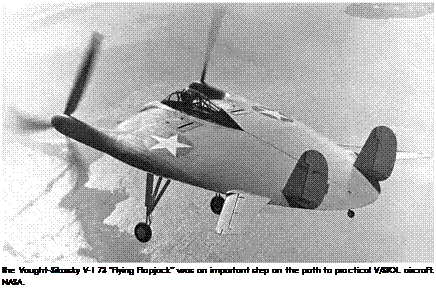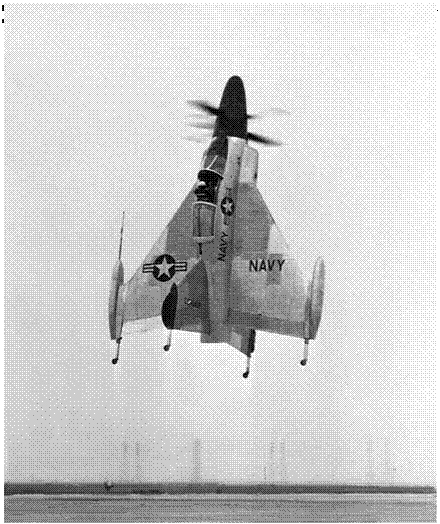On the Up and Up: NASA Takes on V/STOL
![]()

![]()
![]() The advent of vertical flight required mastery of aerodynamics, propulsion, and flight control technology. In the evolution of flight characterized by progressive development of the autogiro, helicopter, and various convertiplanes, the NACA and NASA have played a predominant role. NASA developed the theoretical underpinning for vertical flight, evaluated requisite technologies and research vehicles, and expanded the knowledge base supporting V/STOL flight technology.
The advent of vertical flight required mastery of aerodynamics, propulsion, and flight control technology. In the evolution of flight characterized by progressive development of the autogiro, helicopter, and various convertiplanes, the NACA and NASA have played a predominant role. NASA developed the theoretical underpinning for vertical flight, evaluated requisite technologies and research vehicles, and expanded the knowledge base supporting V/STOL flight technology.
|
O |
NE OF THE MAJOR ACCOMPLISHMENTS in the history of aviation has been the development of practical Vertical Take-Off and Landing (VTOL) aircraft, exemplified by the emergence of the helicopter in the 1930s and early 1940s, and the vectored-thrust
jet airplane of the 1960s. Here indeed was a major challenge that confronted flight researchers, aeronautical engineers, military tacticians, and civilian planners for over 50 years, particularly those of the National Aeronautics and Space Administration (NASA) and its predecessor, the National Advisory Committee for Aeronautics (NACA). While perhaps not regarded by aviation aficionados as being as glamorous as the experimental craft that streaked to new speeds and altitudes, early vertical flight testbeds were likewise revolutionary at the other end of the performance spectrum, in vertical ascents and descents, low-speed controllability, and hover, areas challenging accepted knowledge and practice in aerodynamics, propulsion, and flight controls and controllability.[1330]
The accomplishment of vertical flight was as challenging as inventing the airplane itself. Only four decades after Kitty Hawk were vertical takeoff, hovering, and landing aircraft beginning to enter service. These were, of course, the first helicopters: successors to the interim rotary wing autogiro that relied on a single or multiple rotors to give them Vertical/Short
Take-Off and Landing (V/STOL) performance. Before the end of the Second World War, the helicopter had flown in combat, proved its value as a lifesaving craft, and shown its adaptability for both land – and sea-based operation.[1331] The faded promises of many machines litter the path to the modern V/STOL vehicle. The dedicated research accompanying this work nevertheless led to a class of flight craft that have expanded the use of civil and military aeronautics, saving the lives of nearly a half million people over the last seven decades. The oil rigger in the Gulf going on leave, the yachtsman waiting for rescue, and the infantryman calling in gunships to fend off attack can all thank the flight researchers, particularly those of the NACA and NASA, who made the VTOL aircraft possible.[1332]
![]() Helicopters matured significantly during the Korean war, setting the stage for their pervasive employment in the war in Southeast Asia a decade later.[1333] Helicopters revolutionized warfare and became the iconic image of the Vietnam war. On the domestic front, outstanding helicopter research was being carried on at NASA Langley. Of particular note were the contributions of researchers and test pilots such as Jack Reeder, John P. Campbell, Richard E. Kuhn, Marion O. McKinney, and Robert
Helicopters matured significantly during the Korean war, setting the stage for their pervasive employment in the war in Southeast Asia a decade later.[1333] Helicopters revolutionized warfare and became the iconic image of the Vietnam war. On the domestic front, outstanding helicopter research was being carried on at NASA Langley. Of particular note were the contributions of researchers and test pilots such as Jack Reeder, John P. Campbell, Richard E. Kuhn, Marion O. McKinney, and Robert
H. Kirby. In the late 1950s, military advisers realized how much of the Nation’s defense structure depended on a few large airbases and a few large aircraft carriers. Military interests were driven by the objective of achieving operations into and out of unprepared remotely dispersed sites independent of conventional airfields. Meanwhile, commercial air transportation organizations were pursuing ways to cut the amount of real estate required to accommodate new aircraft and long airstrips.[1334]
 |
|
Since NASAs inception in 1958, its researchers at various Centers have advanced the knowledge base of V/STOL technology via many specialized test aircraft and flying techniques. Some key discoveries include the realization that V/STOL aircraft must be designed with good Short TakeOff and Landing (STOL) performance capability to be cost-effective, and that, arguably, the largest single obstacle to the implementation of STOL powered-lift technology for civil aircraft is the increasingly objectionable level of aircraft-generated noise at airports close to populated areas.
But NASA interest in fixed wing STOL and VTOL convertiplanes predates formation of the Agency, going back to the unsuccessful combined rotor and wing design by Emile and Henry Berliner tested at College Park Airport, MD, in the early 1920s. In the late 1930s and early 1940s, NACA researcher Charles Zimmerman undertook pioneering research on such craft, his interest leading to the Vought V-173, popularly known as the "Flying Flapjack,” because of its peculiar nearcircular wing shape. It led to an abortive Navy fighter concept, the Vought XF5U-1, which was built but never flown. The V-173, however, contributed notably to the emerging understanding of V/STOL aircraft challenges and performance. Aside from this sporadic interest, the Agency’s research staff did not place great emphasis upon such studies until the postwar era. Then, beginning in the early 1950s, a veritable explosion of interest followed, with a number of design studies and flight-test
 |
|
programs undertaken at Langley and Ames laboratories (later the NASA Langley and Ames Research Centers). This interest corresponded to rising interest in the military in the possibility of vertical flight vehicles for a variety of missions.
For example, the U. S. Navy sponsored two unsuccessful experimental "Pogo” tail-sitting turboprop-powered VTOL fighters: the Lockheed XFV-1 and the Convair XFY-1. Only the XFY-1 subsequently operated in true VTOL mode, and flight trials indicated that neither represented a
reasonable approach to practical VTOL flight. The Air Force developed a pure-jet equivalent: the VTOL delta-winged Ryan X-13. Though widely demonstrated (even outside the Pentagon), it was equally impracticable.[1335] The U. S. Army’s Transportation and Research Engineering Command sponsored ducted-fan flying jeep and other saucerlike circular flying platforms by Avro and Hiller, with an equivalent lack of success. Overall, the Army’s far-seeing V/STOL testbed program, launched in 1956 and undertaken in cooperation with the U. S. Navy’s Office of Naval Research, advanced a number of so-called "VZ”-designated research aircraft exploring a range of technical approaches to V/STOL flight.[1336] NATO planners envisioned V/STOL close-air support, interdiction, and nuclear attack aircraft. This interest eventually helped spawn the British Aerospace Harrier strike fighter of the late 1960s and other designs that, though they entered flight-testing, did not prove suitable for operational service.[1337]










